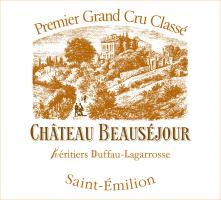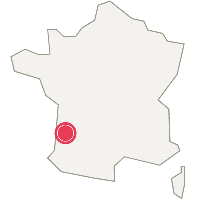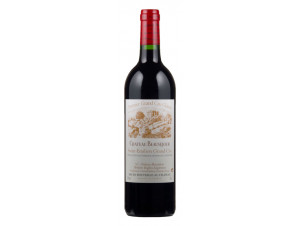You have no items in your shopping cart.
Bordeaux
Château Beauséjour
(16 customer reviews)
Part of the vineyard is planted in clay-limestone soil with asteriated subsoil, while the other part is planted in limestone rock which, at the top of the slope, outcrops in places. Today, 81% of the vines are Merlot, which particularly appreciates the cool, damp character of clay-textured soils, bringing fruit and roundness, and 19% Cabernet (16% Franc and 3% Sauvignon), bringing aromatic power and structure. The average age of the vines is between 35 and 40 years. In maintaining the vineyard and cultivating the vines, from pruning to harvesting, every effort is made to obtain the finest grapes. Find out more
 Recommended by
Recommended byWine Spectator - Wine Enthusiast - Jean-Marc Quarin
24
-
14 result(s)
- Price (€)
- User ratings
- Promotion
-
- (1)
- Guides reviews 🍷
-
- (3)
- (3)
- (2) Read more
- Vintage
-
- (3)
- (1)
- (1) Read more
Bordeaux :
Best rated red wines
Best rated red wines
Bordeaux :
Best rated white wines
Best rated white wines
-

Shipped in
secured packaging - -12%
-

Garantie anti-casse :
Prise en charge totale
The winemaker
Château Beauséjour is one of those prestigious names that flourish on the Right Bank of the Garonne in the Bordeaux region. The estate, nestled atop the Montagne Saint-Emilion, has been a Premier Grand Cru Classé B in the Saint-Emilion Classification since 1955.
In 1851, it was still old buildings that furnished the top of Montagne Saint-Émilion. It was on the basis of these that the château was built and the first vines were planted the same year. At the time, they were owned by the great wine merchants of the time, who used the buildings as storage and ageing cellars for their wines. Barrels of Cheval Blanc and Pétrus, Beau-Séjour and Nénin were stored here and there.
Family after family has run the château, whose reputation is now well established. Most recently, the property was put up for sale early last year. Much coveted by the CEO of Château Angélus and the Cuvelier family (owners of several renowned Médoc châteaux), it was finally the Clarins cosmetics group that acquired the estate last spring. Continuity is assured, however, as the same team remains in place, led by Stéphane Derencourt, one of Bordeaux's most sought-after consultant oenologists. He fell in love with the château, its terroir and its location in 2005, and has been working hard ever since to magnify each vintage.
Situated at the top of the Montagne Saint-Émilion hillside, the vineyard belongs in its entirety to the eponymous appellation. The 12-hectare vineyard is planted on clay-limestone soil on a limestone table, with ideal south-south-west exposure. The grape varieties are rather classic for the region, with a majority of Merlot (70%) and a little Cabernet Franc (30%) to round out the blends. A notable fact that contributes to the complexity of the wines: many of the vines are very old, a good proportion of them having been planted over a hundred years ago!
In terms of ecological commitment, the vineyard is run using integrated farming methods. In other words, at every stage of the vine cycle, natural methods are favored: chemicals are used only when no natural alternative is possible.
Beauséjour wines are fairly typical of Bordeaux's Right Bank: a blend of Merlot (the majority) and Cabernet Franc (the proportions of each vary from cuvée to cuvée). The wines are often aged in 225L oak barrels, giving them aromas of vanilla and lightly toasted toast. Red fruits are also present: fresh and crunchy in wines with a Merlot majority (ex Habit Rouge), more subtle and ripe in the Château Beauséjour cuvée, which lends itself perfectly to ageing. In all cases, Beauséjour wines are the perfect match for tenderly-cooked meat of character, such as Pauillac lamb with confit vegetables. Alternatively, a white truffle risotto is a perfect vegetarian match. Among the estate's wines, you'll find the Château cuvée, of course, but also single-vineyard and signature cuvées from old vines. There's something for everyone!
The history of the estate
In 1851, it was still old buildings that furnished the top of Montagne Saint-Émilion. It was on the basis of these that the château was built and the first vines were planted the same year. At the time, they were owned by the great wine merchants of the time, who used the buildings as storage and ageing cellars for their wines. Barrels of Cheval Blanc and Pétrus, Beau-Séjour and Nénin were stored here and there.
Family after family has run the château, whose reputation is now well established. Most recently, the property was put up for sale early last year. Much coveted by the CEO of Château Angélus and the Cuvelier family (owners of several renowned Médoc châteaux), it was finally the Clarins cosmetics group that acquired the estate last spring. Continuity is assured, however, as the same team remains in place, led by Stéphane Derencourt, one of Bordeaux's most sought-after consultant oenologists. He fell in love with the château, its terroir and its location in 2005, and has been working hard ever since to magnify each vintage.
The terroir
Situated at the top of the Montagne Saint-Émilion hillside, the vineyard belongs in its entirety to the eponymous appellation. The 12-hectare vineyard is planted on clay-limestone soil on a limestone table, with ideal south-south-west exposure. The grape varieties are rather classic for the region, with a majority of Merlot (70%) and a little Cabernet Franc (30%) to round out the blends. A notable fact that contributes to the complexity of the wines: many of the vines are very old, a good proportion of them having been planted over a hundred years ago!
In terms of ecological commitment, the vineyard is run using integrated farming methods. In other words, at every stage of the vine cycle, natural methods are favored: chemicals are used only when no natural alternative is possible.
Beauséjour wines
Beauséjour wines are fairly typical of Bordeaux's Right Bank: a blend of Merlot (the majority) and Cabernet Franc (the proportions of each vary from cuvée to cuvée). The wines are often aged in 225L oak barrels, giving them aromas of vanilla and lightly toasted toast. Red fruits are also present: fresh and crunchy in wines with a Merlot majority (ex Habit Rouge), more subtle and ripe in the Château Beauséjour cuvée, which lends itself perfectly to ageing. In all cases, Beauséjour wines are the perfect match for tenderly-cooked meat of character, such as Pauillac lamb with confit vegetables. Alternatively, a white truffle risotto is a perfect vegetarian match. Among the estate's wines, you'll find the Château cuvée, of course, but also single-vineyard and signature cuvées from old vines. There's something for everyone!

14 wines available
between 58 € and 471.68 €
between 58 € and 471.68 €

247 wine's scans
on Twil application
on Twil application
You might like Voir tous les vins de la région
- -25%
- -30%
- -15%




























 TWIL - Achat de Vin
TWIL - Achat de Vin


